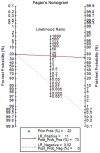Evaluation of PCR in bronchoalveolar lavage fluid for diagnosis of Pneumocystis jirovecii pneumonia: a bivariate meta-analysis and systematic review
- PMID: 24023814
- PMCID: PMC3762835
- DOI: 10.1371/journal.pone.0073099
Evaluation of PCR in bronchoalveolar lavage fluid for diagnosis of Pneumocystis jirovecii pneumonia: a bivariate meta-analysis and systematic review
Abstract
Background: As a promising tool, PCR in bronchoalveolar lavage fluid (BALF) has not been accepted as a diagnostic criterion for PJP.
Objective: We undertook a systematic review of published studies to evaluate the diagnostic accuracy of PCR assays in BALF for PJP.
Methods: Eligible studies from PubMed, Embase and Web of Science reporting PCR assays in BALF for diagnosing PJP were identified. A bivariate meta-analysis of the method's sensitivity, specificity, and positive and negative likelihood ratios with a 95% confidence interval (CI) were analyzed. The post-test probability was performed to evaluate clinical usefulness. A summary receiver operating characteristics (SROC) curve was used to evaluate overall performance. Subgroup analyses were carried out to analysis the potential heterogeneity.
Results: Sixteen studies published between 1994 and 2012 were included. The summary sensitivity and specificity values (95% CI) of PCR in BALF for diagnosis of PJP were 98.3% (91.3%-99.7%) and 91.0% (82.7%-95.5%), respectively. The positive and negative likelihood ratios were 10.894 (5.569-21.309) and 0.018 (0.003-0.099), respectively. In a setting of 20% prevalence of PJP, the probability of PJP would be over 3-fold if the BALF-PCR test was positive, and the probability of PJP would be less than 0.5% if it was negative. The area under the SROC curve was 0.98 (0.97-0.99).
Conclusions: The method of PCR in BALF shows high sensitivity and good specificity for the diagnosis of PJP. However, clinical practice for the diagnosis of PJP should consider the consistent respiratory symptoms, radiographic changes and laboratory findings of the suspected patients.
Conflict of interest statement
Figures





References
-
- Calderon EJ, Gutierrez-Rivero S, Durand-Joly I, Dei-Cas E (2010) Pneumocystis infection in humans: diagnosis and treatment. Expert Rev Anti Infect Ther 8: 683–701. - PubMed
-
- Kaplan JE, Benson C, Holmes KH, Brooks JT, Pau A, et al... (2009) Guidelines for prevention and treatment of opportunistic infections in HIV-infected adults and adolescents: recommendations from CDC, the National Institutes of Health, and the HIV Medicine Association of the Infectious Diseases Society of America. MMWR Recomm Rep 58: 1–207; quiz CE201–204. - PubMed
-
- Kovacs JA, Masur H (2009) Evolving health effects of Pneumocystis: one hundred years of progress in diagnosis and treatment. JAMA 301: 2578–2585. - PubMed
-
- Buchacz K, Baker RK, Palella FJ Jr, Chmiel JS, Lichtenstein KA, et al. (2010) AIDS-defining opportunistic illnesses in US patients, 1994–2007: a cohort study. AIDS 24: 1549–1559. - PubMed
Publication types
MeSH terms
LinkOut - more resources
Full Text Sources
Other Literature Sources
Research Materials

